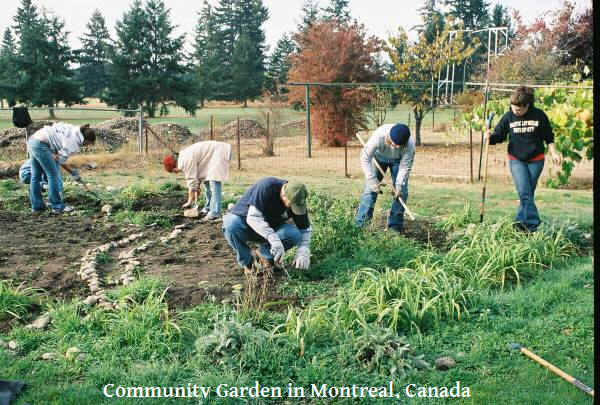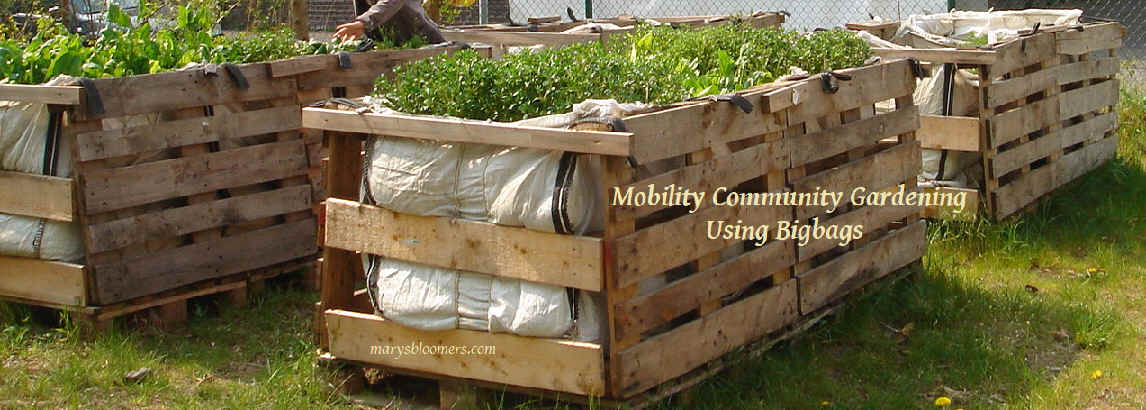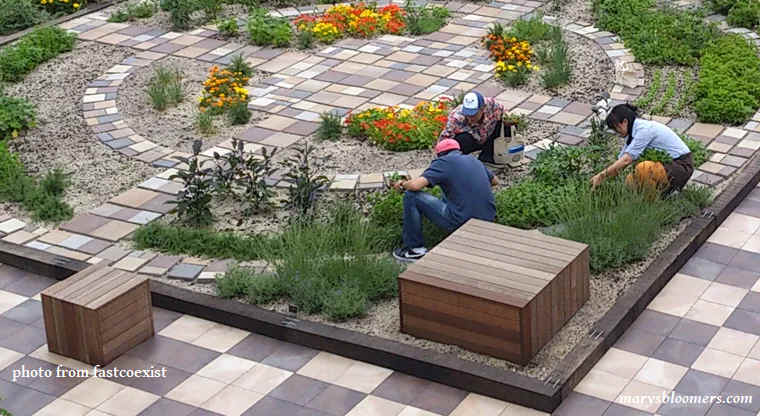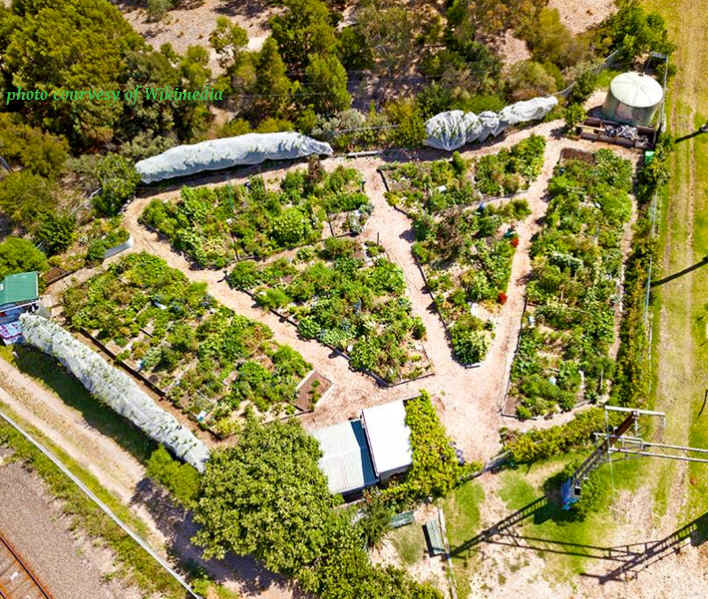|
Designing
And Growing Community Gardens
 |
Community gardens vary
widely throughout the world. And there are as many styles as
there are gardeners. It can be a formal foodscape with flowers
and food, rented by anyone who wants to garde, or it can be a
bare bones functional design meant to feed the community, and
without a lot of structure.
In North America, community gardens range from familiar "victory
garden" areas where people grow small plots of
vegetables, to large "greening" projects to preserve
natural areas, to tiny street beautification planters on urban
street corners.
Some grow only flowers,
others are nurtured communally and their bounty shared. There
are non-profits in many major cities, that offer assistance to
low-income families, children groups, and community
organizations by helping them develop and grow their own
gardens. |
In the UK and the rest of Europe,
closely related "allotment gardens" can have dozens of plots,
each measuring hundreds of square meters and rented by the same family
for generations. In the United
Kingdom, community gardening is generally distinct from allotment
gardening, though the distinction is sometimes blurred. Allotments are
generally plots of land let to individuals for their cultivation by
local authorities or other public bodies—the upkeep of the land is
usually the responsibility of the individual plot owners. Allotments
tend to be situated around the outskirts of built-up areas. Use of
allotment areas as open space or play areas is generally discouraged. There
are an increasing number of community-managed allotments, which may
include allotment plots, and a community garden area, many of them
overseen by the Federation of City Farms and Community Gardens.
In Japan, rooftops on train
stations have been transformed into community gardens and gardens for
those who do not have space to grow their own. Plots are rented to local
residents. These community gardens have become active open spaces. And
they're also geared toward giving stressed-out commuters a place to unwind
and meditate. The most well-known is the Machinaka Vegetable Garden-Sorado
Farm. There are currently five Sorado farms in operation, the largest of
which is on top of the JR Ebisu station in Tokyo. For an annual fee of
just under $1,000 per year in the JR Ebisu garden, anyone can rent a plot
that measures about 32 square feet. The fee includes gardening supplies.
Still sounds pretty pricey to me. Then again, it's in the heart of Tokyo.
Repurposing unattractive, unused spaces into food gardens is a great idea
for a lot of reasons. As one would expect, the Japanese rooftop community
gardens are well-thought out, aesthetically pleasing, and neat as a pin.
In the developing world,
commonly held land for small gardens is a familiar part of the landscape,
even in urban areas, where they may function as market gardens. They also
practice crop rotations with versatile plants.
Community gardens are often
used in urban neighborhoods to alleviate the food desert effect. Food
accessibility described in urban areas refers to residents who have
limited access to fresh produce such as fruits and vegetables. Food
deserts often serve lower-income neighborhoods usually in which residents
are forced to rely on unhealthy food options such as expensive processed
foods from convenience stores, gas stations, and fast-food restaurants.
Community gardens provide accessibility for fresh food to be in closer
proximity located in local neighborhoods. Community gardens can help
expand the realm for ensuring residents’ access to healthy and
affordable food in a community.
These gardens are a way for a
variety of cultures to come together and create a stronger community.
Focusing on creating equitable and respectful spaces where farming
knowledge can be shared is crucial to creating a just food system for all
community members. Communities hold specific knowledge and expertise about
their local environment, and therefore, community members have the power
to play a central role in the creation of their local food system.
Partnerships between academic researchers, farmers/practitioners,
advocates, and community members will filter knowledge of healthy foods
and farming techniques throughout the community as a whole. All of these
benefits will lead, in researcher Montenegro de Wit's opinion, to "a
more egalitarian food system" that "will likely emerge from
participation by those traditionally excluded from it.
Community gardens may help
alleviate one effect of climate change, which is expected to cause a
global decline in agricultural output, making fresh produce increasingly
unaffordable.Co mmunity gardens are also an increasingly popular method of
changing the built environment in order to promote health and wellness in
the face of urbanization. The built environment has a wide range of
positive and negative effects on the people who work, live, and play in a
given area, including a person's chance of developing obesity Community
gardens encourage an urban community's food security, allowing citizens to
grow their own food or for others to donate what they have grown.
Advocates say locally grown food decreases a community's reliance on
fossil fuels for transport of food from large agricultural areas and
reduces a society's overall use of fossil fuels to drive in agricultural
machinery.
These gardens improve users’
health through increased fresh vegetable consumption, and providing a
venue for exercise. A fundamental part of good health is a diet rich in
fresh fruits, vegetables, and other plant based foods. Community
gardens provide access to such foods for the communities in which they are
located. Community gardens are especially important in communities with
large concentrations of low socioeconomic populations, as a lack fresh
fruit and vegetable availability plagues these communities at
disproportionate rates.
Community and school gardens have been
shown to have positive health effects on those who participate in the
programs, particularly in lower rates of obesity in school children.
Many studies have been performed largely in low-income, Hispanic/Latino
communities in the United States. In these programs, gardening
lessons were accompanied by nutrition and cooking classes, and optional
parent engagement. Successful programs highlighted the necessity of
culturally-tailored programming.
There is some evidence to suggest that
community gardens have a similar effect in adults. A study found that
community gardeners in Utah had a lower body mass index than their
non-gardening siblings and unrelated neighbors. Administrative
records were used to compare body mass indexes of community gardeners to
that of unrelated neighbors, siblings, and spouses. Gardeners were less
likely to be overweight or obese than their neighbors, and gardeners had
lower body mass indexes than their siblings. However, there was no
difference in body mass index between gardeners and their spouses which
may suggest that community gardening creates healthy habits for the entire
household.
Participation in a community garden has
been shown to increase both availability and consumption of fruits and
vegetables in households. A study showed an average increase in
availability of 2.55 fruits and 4.3 vegetables with participation in a
community garden. It also showed that children in participating
households consumed an average of two additional servings per week of
fruits and 4.9 additional servings per week of vegetables.
The gardens bring urban dwellers closer to
the source of their food, and break down isolation, by creating a social
community. Community gardens provide other social benefits, such as the
sharing of food production, knowledge of the wider community, and safer
living spaces. Active communities experience less crime and
vandalism.
|

Big Bag Bed comes in
sizes up to 12 ft. long. Inserts placed internally in the bed aid
in keeping raised beds upright. No construction required. The Big
Bag also air prunes roots while protecting plants from underground
pests Just unfold, fill and plant. They are usually placed on the
ground, but i like this wooden enclosure thing better. The built
wood frame in this garden keeps the heavy full bag from sagging,
keeps the garden level for disabled gardeners, and gardeners who
just don't want to keep bending down. Easier to water, weed and
fertilize. And easy to harvest your crops. The bag gardens in wood
enclosures are a great idea for your own garden. Elevated cedar
raised bed gardens cost upwards of $100 each, and are only about 4
ft. long. And they are not even half as deep as these bag
gardens. I use the cedar beds when i find them on sale,
because i decorate them with mostly floral plants and fountains. I
would opt for these for an intense and space-saving vegetable
garden.
The bag-in-a-box idea shown here, keeps weeding chores to a
minimum, the community appreciates the neatness, the plants are
snug and keeps critters from bothering them. Awesome. I use the
smaller (7-10 gallon) sizes as portable large planters when i
start shrubs that i don't want to put in the ground yet, until I
have a plan. The smaller bags have handles, and i find it way
easier to move them around than plastic pots. These are a blessing
for all gardeners, but especially those with special gardening
needs. You can grow an entire garden in one of the Big Bags, and
community gardens can designate a bag for each crop, which makes
it more organized. Or an allotment garden can be planned so that
each gardener grows their crops in a "rented" bag. At
the end of the season, you can leave the soil in. The bags are
weatherproof. |
Land for a community garden
can be publicly or privately held. One strong tradition in North American
community gardening in urban areas is cleaning up abandoned vacant lots
and turning them into productive gardens. Alternatively, community gardens
can be seen as a health or recreational amenity and included in public
parks, similar to ball fields or playgrounds. Historically, community
gardens have also served to provide food during wartime or periods of
economic depression. Access to land and security of land tenure remains a
major challenge for community gardeners and their supporters throughout
the world, since in most cases the gardeners themselves do not own or
control the land directly.
Types
of gardens
There are multiple types of
community gardens with distinct varieties in which the community can
participate in.
-
Neighborhood gardens
are the most common type that is normally defined as a garden where a
group of people come together to grow fruits, vegetables and
ornamentals. They are identifiable as a parcel of private or public
land where individual plots are rented by gardeners at a nominal
annual fee.
-
Residential Gardens
are typically shared among residents in apartment communities,
assisted living, and affordable housing units. These gardens are
organized and maintained by residents living on the premise.
-
Institutional Gardens are
attached to either public or private organizations and offer numerous
beneficial services for residents. Benefits include mental or physical
rehabilitation and therapy, as well as teaching a set of skills for
job-related placement.
-
Demonstration Gardens
are used for educational and recreational purposes in mind. They often
offer short seminars or presentations about gardening, and provide the
necessary tools to operate a community garden.
-
Plot
size
In Britain, the 1922 Allotment
act specifies "an allotment not exceeding 40 [square] poles in
extent". In practice, plot sizes vary; Lewisham
offers plots with an "average size" of "125 meters
square". In America there is no standardized plot size.
Community gardens may be found
in neighborhoods, schools, hospitals, and on residential housing grounds.
The location of a community garden is a critical factor in how often the
community garden is used and who visits it.
The site location should also
be considered for its soil conditions as well as sun conditions. Solar
conditions are of paramount importance, as above ground gardening is
always possible. An area with a fair amount of morning sunlight and shade
in the afternoon is most ideal. While specifics vary from plant to plant,
most do well with 6 to 8 full hours of sunlight.
Plant
choice and physical layout
While food
production is central to many community and allotment gardens, not all
have vegetables as a main focus. Restoration of natural areas and native
plant gardens are also popular, as are "art" gardens. Many
gardens have several different planting elements, and combine plots with
such projects as small orchards, herbs and butterfly gardens. Individual
plots can become "virtual" backyards.
Regardless of plant choice,
planning out the garden layout beforehand will help avoid problems down
the line. According to the Arizona Master Gardener Manual, taking
measurements of the garden size, sunlight locations and planted crops vs.
yield quantity, will ensure a detailed record that helps when making
decisions for the coming years. Other consideration to garden layout would
be efficient use of space by using trellises for climbing crops, being
mindful of taller plants blocking sunlight to shorter plants and plants
that have similar life cycles close together
Gardeners may form a
grassroots group to initiate the garden, such as the Green Guerrillas of
New York City,
or a garden may be organized "top down" by a municipal
agency. |





